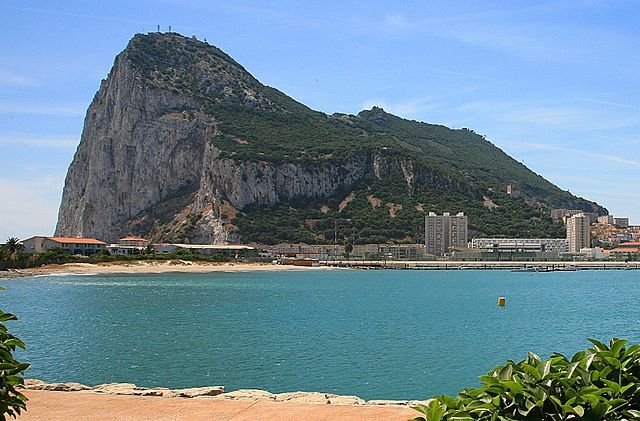The WWII Plan To Bury Spies Alive

Gibraltar is a British Overseas Territory and peninsular city on the southern tip of the Iberian Peninsula, connected to mainland Spain. (Here’s a map.) It’s been under British control for more than 300 years — not without controversy, but that’s a story for another day (and a different publication). Gibraltar sits at the Straits of Gibraltar, where the Atlantic meets the Mediterranean Sea, and second, a large percentage of its area is taken up by the Rock of Gibraltar, a limestone outcropping that extends nearly 1,400 feet (425 meters) above sea level, seen above. Combined, these features make Gibraltar very important, strategically — it’s a fantastic place to monitor naval traffic, both in peacetime and in war.
And during World War II, the British weren’t going to abandon it — no matter what.
Before the war, many British citizens lived in Gibraltar, but that changed quickly after the war broke out. Britain evacuated the peninsula, relocating most of the population to London and Morocco. In their place came the military, which began building a base in the Rock itself. As Atlas Obscura summarizes, “The British Army dug a maze of defensive tunnels inside the rock during the Second World War, and the massive cliff is famous for the more than 30 miles of cleared space that served as a housing area for guns, ammunition, barracks, and even hospitals for wounded soldiers.” The base at Gibraltar was used to patrol the waters and monitor the skies — and to defend itself in case of invasion.
The risk of that was real. The strategic value of Gibraltar to Germany was clear, and on top of that, Spain wanted the UK out. Even though Spain was neutral during the war, as MI5’s official website notes, “Spain did not actually join the Axis side but it collaborated with the Nazis in many areas. The Spanish intelligence service had a close working relationship with its German opposite number, the Abwehr. The two countries had common interests in Gibraltar. Spain had long claimed ownership of the territory, which had been held by Britain since 1703, and Germany wanted to break Britain’s control of the vital Straits of Gibraltar to secure naval access to the Mediterranean.” If Germany wanted to send troops through Spain to get control of Gibraltar, Great Britain was going to have a hard time stopping them.
That never came to pass, but the UK planned for it anyway — one that involved burying some troops alive. Kind of. As part of that maze of tunnels was something called the “Stay Behind Cave,” a two-story bunker. The first floor of the bunker, per the Gibraltar National Museum, was nothing more than a room “with bare rock walls and a wooden floor which led to a spacious room measuring approximately 18 x 5.5m. The flooring in this room was made from cork tiles which would have provided great sound insulation. As you entered the room, you could see a sink and tap at the far right which was supplied by a metal water tank located just behind the southern wall.” Up the stairs were two more rooms — a bathroom and a radio transmitting station. And if you went up the stairs a bit more, you came to “a natural opening in the rock which would have allowed the men to exit onto a small natural platform high up on the east side cliffs, where hidden in the undergrowth they would have seen the entire coastline,” per the Museum. (You can see a diagram of the bunker on the Museum’s site.)
The plan, according to Atlas Obscura, was for six British soldiers stationed at Gibraltar to brick themselves into the Stay Behind Cave if Germany were to successfully take over the Rock. The Cave was outfitted with enough supplies to last a year; after that, the soldiers were expected to bury each other in the floor — unless the British Army could save them beforehand.
That never came to pass. Germany never entered Spain and the six men who practiced for the worst never had to huddle in the Cave. Today, you can experience their plans if you want, but not for a year — while the Stay Behind Cave is part of guided tours run by the Gibraltar National Museum, the tours last only an hour.
Bonus fact: The British troops stationed in Gibraltar in World War II weren’t just there to keep an eye out for the Germans. They were also there to protect some monkeys. Gibraltar is currently home to about 300 Barbary macaques, and famously so — they are one of the area’s biggest tourist attractions. The government of Gibraltar is currently entrusted with the care of the Barbary macaques, but that wasn’t always the case. From 1915 to 1991 — a period which includes all of World War II — the British military regiment assigned to Gibraltar watched after the monkeys. A “Keeper of the Apes” was specifically in charge, maintaining a register of the macaques and ensuring they were fed and well cared for. Per Wikipedia’s editors, “any ill or injured monkey needing surgery or any other form of medical attention was taken to Royal Naval Hospital Gibraltar and received the same treatment as would an enlisted service man.”
From the Archives: Atlantropa: The German plan to dam the Straits of Gibraltar and drain the Mediterranean.
